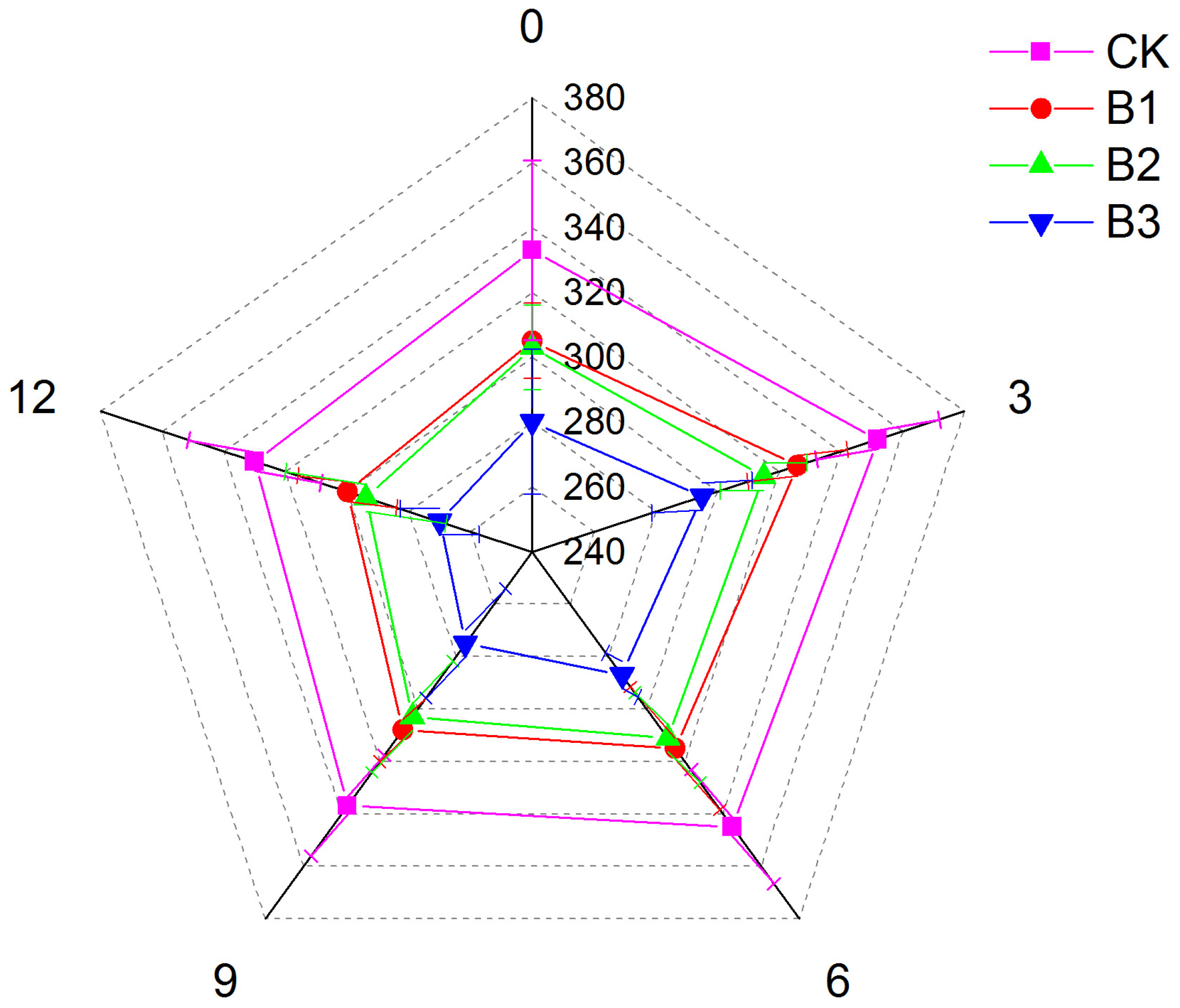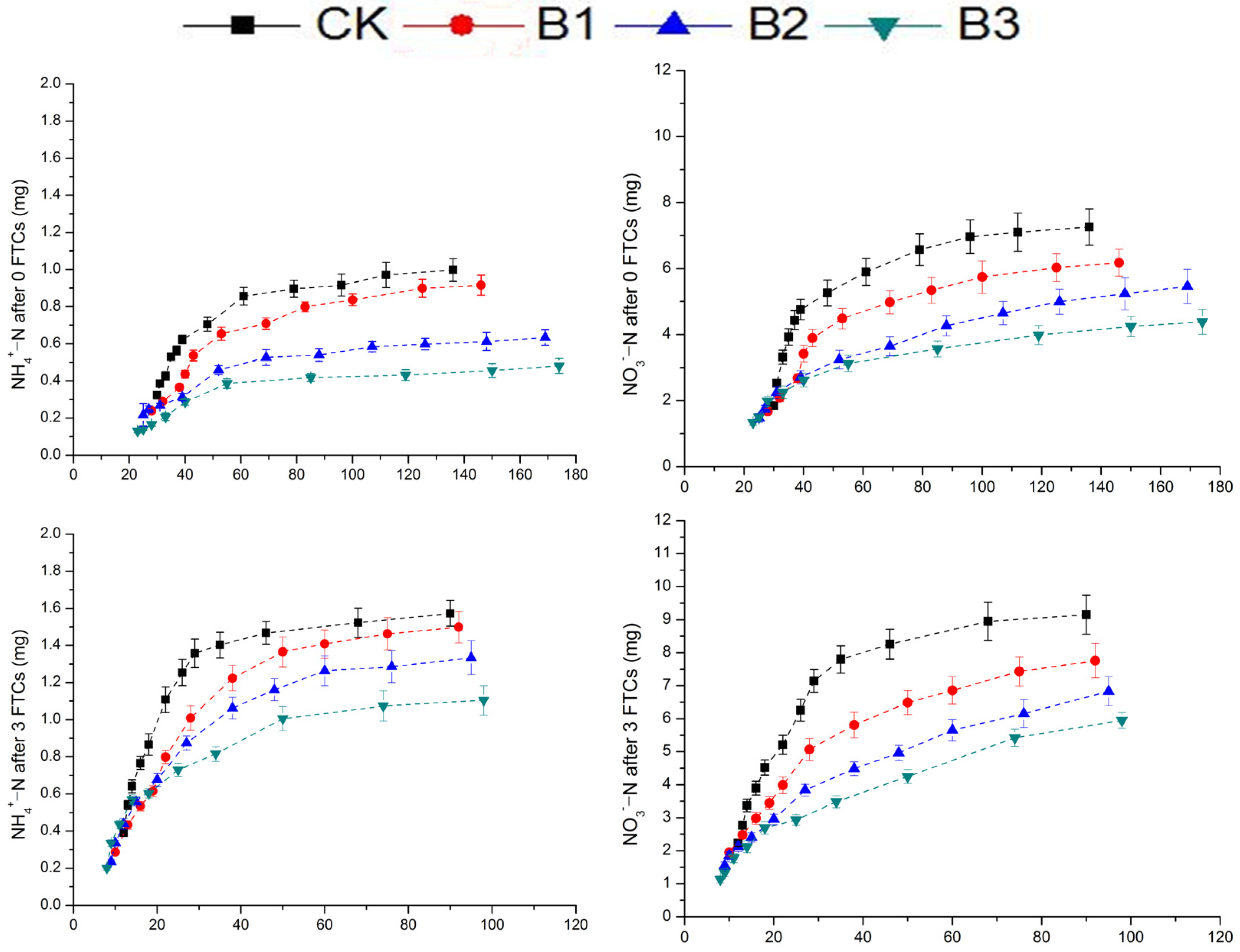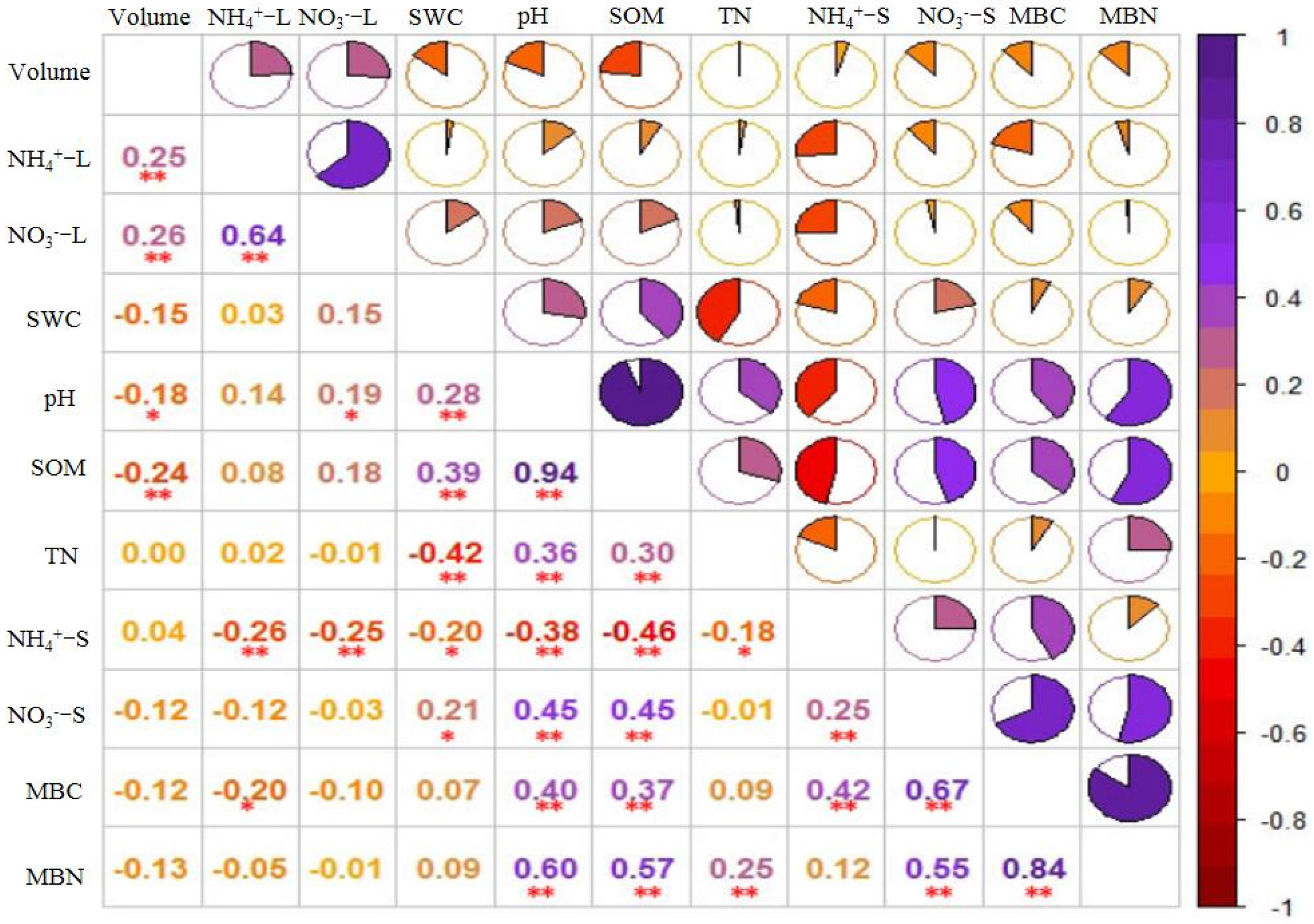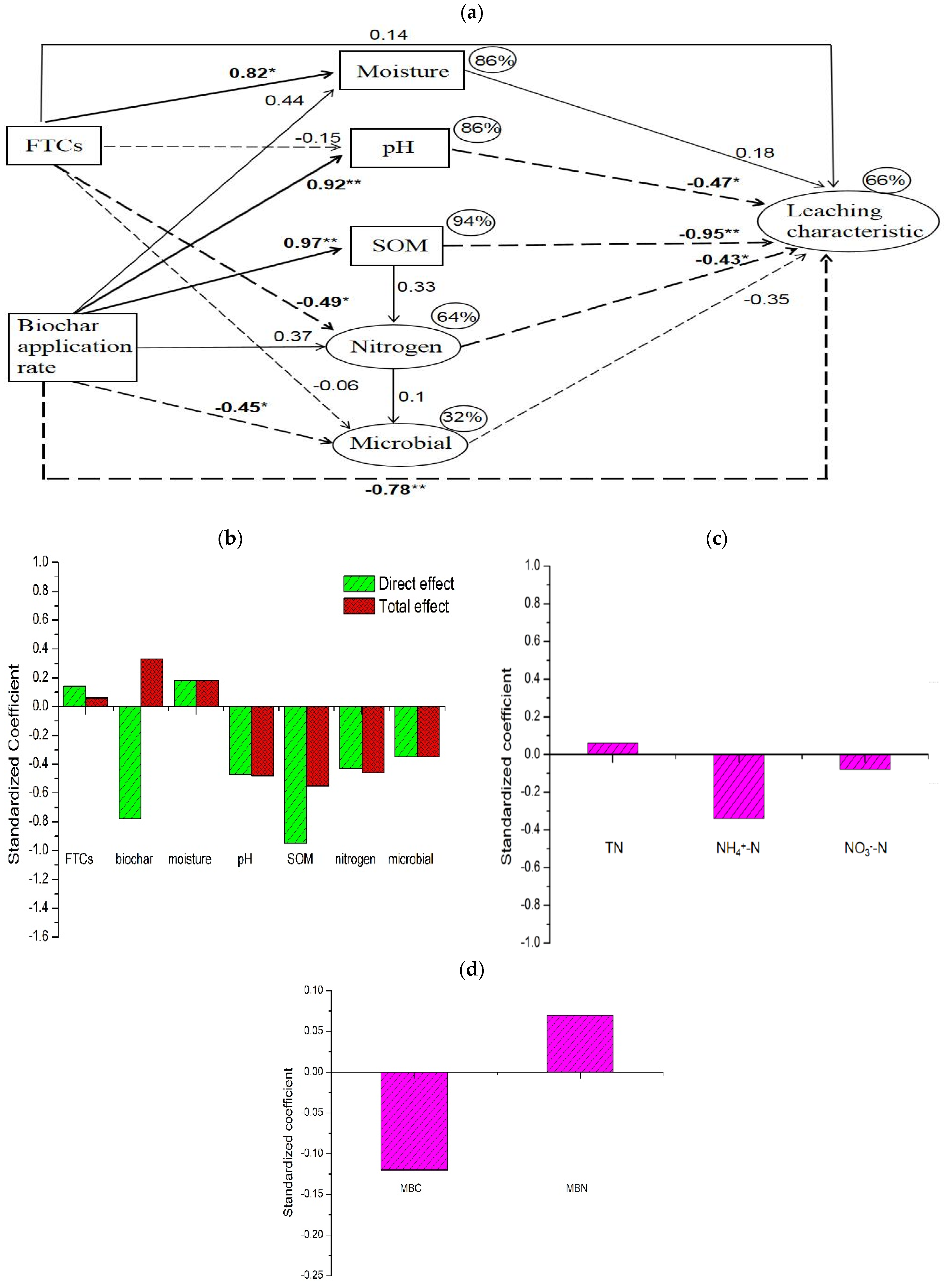Combined Effect of Freeze–Thaw Cycles and Biochar Addition on Soil Nitrogen Leaching Characteristics in Seasonally Frozen Farmland in Northeast China
Abstract
:1. Introduction
2. Materials and Methods
2.1. Soil and Biochar
2.2. Simulated Freeze–Thaw Experiment
2.3. Leaching Experiment
2.4. Soil Analyses
2.5. Data Analyses
3. Results and Analysis
3.1. Leaching Characteristics
3.2. Soil Quality Indicator Characteristics
3.3. Effects of Soil Quality Indicators on Leaching Characteristics
3.4. Path Analysis of the Effects of FTCs, Biochar Addition Ratio, and Soil Quality Indicators on Nitrogen Leaching Characteristics
4. Discussion
4.1. Nitrogen Leaching Characteristics under FTCs
4.2. Nitrogen Leaching Characteristics for Different Biochar Addition Ratios
4.3. Effects of the Biochar Addition Ratios on Nitrogen Leaching under FTCs
5. Conclusions
Author Contributions
Funding
Data Availability Statement
Conflicts of Interest
References
- Wu, M.S.; Zhao, Q.; Jansson, P.E.; Wu, J.W.; Tan, X.; Duan, Z.; Wang, K.; Chen, P.; Zheng, M.J.; Huang, J.S.; et al. Improved soil hydrological modeling with the implementation of salt-induced freezing point depression in CoupModel: Model calibration and validation. J. Hydrol. 2021, 596, 125693. [Google Scholar] [CrossRef]
- Bao, T.; Xu, X.; Jia, G.; Billesbach, D.P.; Sullivan, R.C. Much stronger tundra methane emissions during autumn freeze than spring thaw. Glob. Chang. Biol. 2021, 27, 376–387. [Google Scholar] [CrossRef]
- Chen, P.; Liu, Y.; Mo, C.; Jiang, Z.; Yang, J.; Lin, J. Microbial mechanism of biochar addition on nitrogen leaching and retention in tea soils from different plantation ages. Sci. Total Environ. 2021, 757, 143817. [Google Scholar] [CrossRef] [PubMed]
- Zhou, Y.; Berruti, F.; Greenhalf, C.; Tian, X.; Henry, H.A. Increased retention of soil nitrogen over winter by biochar application: Implications of biochar pyrolysis temperature for plant nitrogen availability. Agr. Ecosyst. Environ. 2017, 236, 61–68. [Google Scholar] [CrossRef]
- Ding, S.; Zou, Y.; Yu, X. Freeze-thaw cycles alter the growth sprouting strategy of wetland plants by promoting denitrification. Commun. Earth Environ. 2023, 4, 57. [Google Scholar] [CrossRef]
- Liu, H.Y.; Li, H.B.; Zhang, A.P.; Rahaman, M.A.; Yang, Z.L. Inhibited effect of biochar application on N2O emissions is amount and time-dependent by regulating denitrification in a wheat-maize rotation system in North China. Sci. Total Environ. 2020, 721, 137636. [Google Scholar] [CrossRef]
- Karhu, K.; Kalu, S.; Seppänen, A.; Kitzler, B.; Virtanen, E. Potential of biochar soil amendments to reduce N leaching in boreal field conditions estimated using the resin bag method. Agr. Ecosyst. Environ. 2021, 316, 107452. [Google Scholar] [CrossRef]
- Song, Y.; Zou, Y.C.; Wang, G.P.; Yu, X.F. Stimulation of nitrogen turnover due to nutrients release from aggregates affected by freeze-thaw in wetland soils. Phys. Chem. Earth. 2017, 97, 3–11. [Google Scholar] [CrossRef]
- Gao, D.; Zhang, L.; Liu, J.; Peng, B.; Fan, Z.; Dai, W.; Bai, E. Responses of terrestrial nitrogen pools and dynamics to different patterns of freeze-thaw cycle: A meta-analysis. Glob. Change Biol. 2017, 24, 2377–2389. [Google Scholar] [CrossRef]
- Hu, R.; Wang, X.P.; Xu, J.S.; Zhang, Y.F.; Pan, Y.X.; Su, X. The mechanism of soil nitrogen transformation under different biocrusts to warming and reduced precipitation: From microbial functional genes to enzyme activity. Sci. Total Environ. 2020, 722, 137849. [Google Scholar] [CrossRef]
- Zhang, Y.F.; Wang, J.M.; Feng, Y. The effects of biochar addition on soil physicochemical properties: A review. Catena 2021, 202, 105284. [Google Scholar] [CrossRef]
- Chen, Z.; Yang, S.Q.; Zhang, A.P.; Jing, X.; Song, W.M.; Mi, Z.R.; Zhang, Q.W.; Wang, W.Y.; Yang, Z.L. Nitrous oxide emissions following seasonal freeze-thaw events from arable soils in Northeast China. J. Integr. Agr. 2018, 17, 231–246. [Google Scholar] [CrossRef]
- Campbell, J.L.; Socci, A.M.; Templer, P.H. Increased nitrogen leaching following soil freezing is due to decreased root uptake in a northern hardwood forest. Glob. Change Biol. 2014, 20, 2663–2673. [Google Scholar] [CrossRef] [PubMed]
- Wang, S.; Wang, D.; Liu, T.; Liu, Y.; Luo, M.; Li, Y.; Zhou, W.; Yang, M.; Liang, S.; Li, K. Simulation of winter wheat growth dynamics and optimization of water and nitrogen application systems based on the aquacrop model. Agronomy 2024, 14, 110. [Google Scholar] [CrossRef]
- Han, L.F.; Sun, K.; Yang, Y.; Xia, X.H.; Li, F.B.; Yang, Z.F.; Xing, B.S. Biochar’s stability and effect on the content, composition and turnover of soil organic carbon. Geoderma 2020, 364, 114184. [Google Scholar] [CrossRef]
- Yang, W.; Wang, Z.; Guo, S.; Yang, M.; Zhao, L.; Zhao, H.; Jia, H.; Xu, W. Evaluation of soil fertility quality under biochar combined with nitrogen in an irrigated wheat field in Northern Xinjiang, China. Agronomy 2023, 13, 2518. [Google Scholar] [CrossRef]
- Yang, Y.Q.; Cui, M.H.; Ren, Y.G.; Guo, J.C.; Liu, H. Correlations between the physicochemical characteristics and adsorption capacity of sludge-based biochar induced at pyrolysis temperature. J. Shenzhen Univ. Sci. Eng. 2020, 37, 194–201. [Google Scholar] [CrossRef]
- Romero, C.M.; Hao, X.Y.; Li, C.L.; Owens, J.; Schwinghamer, T.; McAllister, T.A.; Okine, E. Nutrient retention, availability and greenhouse gas emissions from biochar fertilized Chernozems. Catena 2021, 198, 105046. [Google Scholar] [CrossRef]
- El-Naggar, A.; Lee, S.S.; Rinklebe, J.; Farooq, M.; Song, H.; Sarmah, A.K.; Zimmerman, A.R.; Ahmad, M.; Shaheen, S.M.; Ok, Y.S. Biochar application to low fertility soils: A review of current status, and future prospects. Geoderma 2019, 337, 536–554. [Google Scholar] [CrossRef]
- Kettunen, R.; Saarnio, S. Biochar can restrict N2O emissions and the risk of nitrogen leaching from an agricultural soil during the freeze-thaw period. Agr. Food Sci. 2013, 22, 373–379. [Google Scholar] [CrossRef]
- FAO. Soils Map of the World: Revised Legend; Food and Agriculture Organization of the United Nations: Rome, Italy, 1988. [Google Scholar]
- Liao, J.Y.; Hu, A.; Zhao, Z.W.; Liu, X.R.; Jiang, C.; Zhang, Z.H. Biochar with large specific surface area recruits N2O-reducing microbes and mitigate N2O emission. Soil. Biol. Biochem. 2021, 156, 108212. [Google Scholar] [CrossRef]
- Yang, X.Y.; Chen, X.W.; Yang, X.T. Phosphorus release kinetics and solubility capacity of phosphorus fractionation induced by organic acids from a black soil in northeast China. Can. J. Soil. Sci. 2019, 99, 92–99. [Google Scholar] [CrossRef]
- Wei, T.; Simko, V.; Levy, M.; Xie, Y.; Jin, Y.; Zemla, J. Package ‘corrplot’. Statistician 2017, 56, 316–324. [Google Scholar]
- Macdonald, J.A.; Dise, N.B.; Matzner, E.; Armbruster, M.; Gundersen, P.; Forsius, M. Nitrogen input together with ecosystem nitrogen enrichment predict nitrate leaching from European forests. Glob. Change Biol. 2002, 8, 1028–1033. [Google Scholar] [CrossRef]
- Jaakkola, A. Leaching losses of nitrogen from a clay soil under grass and cereal crops in Finland. Plant Soil. 1984, 76, 59–66. [Google Scholar] [CrossRef]
- Zong, R.; Wang, Z.H.; Li, W.H.; Ayantobo, O.O.; Li, H.Q.; Song, L.B. Assessing the impact of seasonal freezing and thawing on the soil microbial quality in arid northwest China. Sci. Total Environ. 2023, 863, 161029. [Google Scholar] [CrossRef] [PubMed]
- Wu, X.; Wang, F.F.; Li, T.; Fu, B.J.; Lv, Y.H.; Liu, G.H. Nitrogen additions increase N2O emissions but reduce soil respiration and CH4 uptake during freeze-thaw cycles in an alpine meadow. Geoderma 2020, 363, 114157. [Google Scholar] [CrossRef]
- Christopher, S.F.; Shibata, H.; Ozawa, M.; Nakagawa, Y.; Mitchell, M.J. The effect of soil freezing on N cycling: Comparison of two headwater subcatchments with different vegetation and snowpack conditions in the northern Hokkaido Island of Japan. Biogeochemistry 2008, 88, 15–30. [Google Scholar] [CrossRef]
- Joseph, G.; Henry, H.A.L. Soil nitrogen leaching losses in response to freeze-thaw cycles and pulsed warming in a temperate old field. Soil Biol. Biochem. 2008, 40, 1947e1953. [Google Scholar] [CrossRef]
- Schmidt, H.P.; Kammann, C.; Hagemann, N.; Leifeld, J.; Bucheli, T.D.; Sánchez Monedero, M.A.; Cayuela, M.L. Biochar in agriculture-A systematic review of 26 global meta-analyses. GCB Bioenergy 2021, 13, 1708–1730. [Google Scholar] [CrossRef]
- Xu, N.; Tan, G.C.; Wang, H.Y.; Gai, X.P. Effect of biochar additions to soil on nitrogen leaching, microbial biomass and bacterial community structure. Eur. J. Soil. Biol. 2016, 74, 1–8. [Google Scholar] [CrossRef]
- Zhao, X.; Wang, S.Q.; Xing, G.X. Nitrification, acidification, and nitrogen leaching from subtropical cropland soils as affected by rice straw-based biochar: Laboratory incubation and column leaching studies. J. Soils Sediments 2014, 14, 471–482. [Google Scholar] [CrossRef]
- Lei, Z.F.; Li, Q.; Song, X.Z.; Wang, W.F.; Zhang, Z.T.; Peng, C.H.; Tian, L.L. Biochar mitigates dissolved organic carbon loss but does not affect dissolved organic nitrogen leaching loss caused by nitrogen deposition in Moso bamboo plantations. Glob. Ecol. Conserv. 2018, 16, e00494. [Google Scholar] [CrossRef]
- Zhang, C.; Huang, X.; Zhang, X.; Wan, L.; Wang, Z. Effects of biochar application on soil nitrogen and phosphorous leaching loss and oil peony growth. Agr. Water Manag. 2021, 255, 107022. [Google Scholar] [CrossRef]
- Novak, J.M.; Busscher, W.J.; Watts, D.W.; Amonette, J.E.; Ippolito, J.A.; Lima, I.M.; Gaskin, J.; Das, K.C.; Steiner, C.; Ahmedna, M.; et al. Biochars impact on soil-moisture storage in an ultisol and two aridisols. Soil. Sci. 2012, 177, 310–320. [Google Scholar] [CrossRef]
- Campbell, J.L.; Reinmann, A.B.; Templer, P.H. Soil freezing effects on sources of nitrogen and carbon leached during snowmelt. Soil. Sci. Soc. Am. J. 2013, 78, 297–308. [Google Scholar] [CrossRef]
- Li, S.; Zhang, Y.; Yan, W.; Shangguan, Z. Effect of biochar application method on nitrogen leaching and hydraulic conductivity in a silty clay soil. Soil. Till Res. 2018, 183, 100–108. [Google Scholar] [CrossRef]
- Mukherjee, A.; Zimmerman, A.R.; Harris, W. Surface chemistry variations among a series of laboratory-produced biochars. Geoderma 2011, 163, 247–255. [Google Scholar] [CrossRef]
- Sun, H.J.; Lu, H.Y.; Chu, L.; Shao, H.B.; Shi, W.M. Biochar applied with appropriate rates can reduce N leaching, keep N retention and not increase NH3 volatilization in a coastal saline soil. Sci. Total Environ. 2017, 575, 820–825. [Google Scholar] [CrossRef]
- Holub, P.; Klem, K.; Tůma, I.; Vavříková, J.; Surá, K.; Veselá, B.; Záhora, J. Application of organic carbon affects mineral nitrogen uptake by winter wheat and leaching in subsoil: Proximal sensing as a tool for agronomic practice. Sci. Total Environ. 2020, 717, 137058. [Google Scholar] [CrossRef]







| Leaching Characteristics | Biochar Addition Ratio | FTCs | Biochar Addition Ratio × FTCs | |||
|---|---|---|---|---|---|---|
| F | Sig. | F | Sig. | F | Sig. | |
| Volume | 4.468 | 0.005 | 0.062 | 0.993 | 3.247 | 0.001 |
| NH4+-N | 59.863 | 0.000 | 9.161 | 0.000 | 19.781 | 0.000 |
| NO3−-N | 15.014 | 0.000 | 3.117 | 0.018 | 27.354 | 0.000 |
| Soil Quality Indicator | Biochar Addition Ratio | FTCs | Biochar Addition Ratio × FTCs | |||
|---|---|---|---|---|---|---|
| F | Sig. | F | Sig. | F | Sig. | |
| Moisture | 35.38 | 0.000 | 257.14 | 0.000 | 2.86 | 0.001 |
| pH | 459.07 | 0.000 | 14.47 | 0.000 | 0.74 | 0.711 |
| SOM | 2329.35 | 0.000 | 55.84 | 0.000 | 3.93 | 0.000 |
| TN | 12.07 | 0.000 | 39.19 | 0.000 | 0.13 | 1.000 |
| NH4+-N | 56.83 | 0.000 | 73.63 | 0.000 | 2.13 | 0.018 |
| NO3−-N | 76.02 | 0.000 | 132.03 | 0.000 | 4.99 | 0.000 |
| MBC | 145.301 | 0.000 | 1067.649 | 0.000 | 5.228 | 0.000 |
| MBN | 121.510 | 0.000 | 229.844 | 0.000 | 1.234 | 0.271 |
Disclaimer/Publisher’s Note: The statements, opinions and data contained in all publications are solely those of the individual author(s) and contributor(s) and not of MDPI and/or the editor(s). MDPI and/or the editor(s) disclaim responsibility for any injury to people or property resulting from any ideas, methods, instructions or products referred to in the content. |
© 2024 by the authors. Licensee MDPI, Basel, Switzerland. This article is an open access article distributed under the terms and conditions of the Creative Commons Attribution (CC BY) license (https://creativecommons.org/licenses/by/4.0/).
Share and Cite
Wang, L.; Li, T.; Liu, H.; Zhang, Z.; Yang, A.; Li, H. Combined Effect of Freeze–Thaw Cycles and Biochar Addition on Soil Nitrogen Leaching Characteristics in Seasonally Frozen Farmland in Northeast China. Agronomy 2024, 14, 153. https://doi.org/10.3390/agronomy14010153
Wang L, Li T, Liu H, Zhang Z, Yang A, Li H. Combined Effect of Freeze–Thaw Cycles and Biochar Addition on Soil Nitrogen Leaching Characteristics in Seasonally Frozen Farmland in Northeast China. Agronomy. 2024; 14(1):153. https://doi.org/10.3390/agronomy14010153
Chicago/Turabian StyleWang, Lihong, Tianxiao Li, Hui Liu, Zuowei Zhang, Aizheng Yang, and Hongyu Li. 2024. "Combined Effect of Freeze–Thaw Cycles and Biochar Addition on Soil Nitrogen Leaching Characteristics in Seasonally Frozen Farmland in Northeast China" Agronomy 14, no. 1: 153. https://doi.org/10.3390/agronomy14010153





